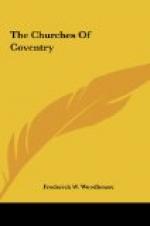At the same time he gave them “liberty to have a postern into the Park to carry out any of their convent that should be diseased.”
The house was surrendered to the King in 1539, the warden and ten brethren being compelled to sign a humiliating document, in which they professed to “profoundly consider that the perfection of Christian living doth not consist in dumb ceremonies, wearing of a grey coat, disguising ourself after strange fashions, ducking, nodding and becking, in girding our selves with a girdle full of knots and other like Papisticall ceremonies.”
[Illustration: THE SPIRE OF CHRIST CHURCH.]
It is certain at least that they had no accumulated wealth. Whatever they had received had been distributed for the advantage of the Church or the poor. At their suppression they had neither lands, tenements, nor other possessions, save their church and house and the land these stood on. The site was granted to the city and the buildings thrown down, only the spire with its supporting walls and arches being allowed to stand until 1829, when it was incorporated with the new nave of Christ Church from the designs of Rickman, to whom we are indebted for the first comprehensive and systematic account of English Mediaeval architecture. The work shows how imperfectly in those days even a genuine admirer of Mediaeval Art understood its spirit. Unfortunately the tower and spire were recased with new stone, and the original character of the work largely disappeared. The total height is 204 feet, exclusive of the vane. The plan of the old church was interesting, especially in the arrangement of the crossing. The short transepts had little real relation to choir or nave, which were almost completely separated from one another, the nave being intended for the use of the public.
The narrowing of the tower from east to west, and the insertion of secondary north and south arches to carry the slender octagonal tower is unusual and ingenious. The whole length was 250 feet, and the transepts were 96 feet from north to south. The nave and choir differed little in length.
[Illustration: GREY FRIARS’ CHURCH (CROSSING).]
The connection of the Franciscans with the production of the Mysteries, or sacred plays, should not pass unnoticed. Dugdale, who had spoken with eye witnesses, thus alludes to the subject:
Before the suppression of the Monasteries this City was very famous for the Pageants that were played therein upon Corpus Christi-day; which occasioning very great confluence of people thither from far and near, was of no small benefit thereto; which Pageants being acted with mighty State and Reverence by the Friars of this House, had Theatres for the several scenes, very large and high, placed upon wheels and drawn to all the eminent parts of the City for the better advantage of spectators; and contained the story of the Old and New Testament, composed in the old English Rithme, as appeareth by an ancient MS. intituled, Ludus Corporis Christi, or Ludus Coventriae.
Along with a number that were performed by the city companies they are still to be seen in the British Museum. We know that the Friars presented them as late as 1492, when Henry VII was present with his Queen to see the plays “acted by the Grey Friars.”




